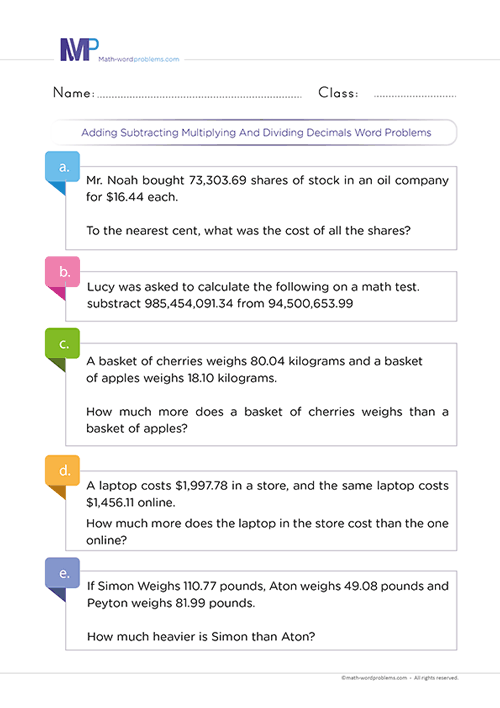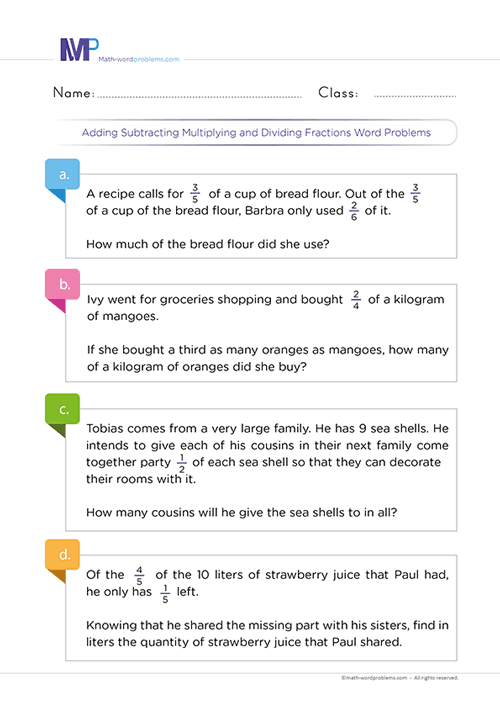 How to solve addition, subtraction, multiplication and division of whole numbers word problems
How to solve addition, subtraction, multiplication and division of whole numbers word problems

- INTRODUCTION
- Step 1 IDENTIFY THE PROBLEM
- Step 2 STRATEGIZE OR GATHER RELEVANT INFORMATION
- Step 3 CREATE AN EQUATION
- Step 4 PROVIDE A SOLUTION
- Step 5 CHECK YOUR WORK
- Examples Examples on how to do addition, subtraction, multiplication, and division of whole word problems
Get more contents on this skill...
Here is a fantastic guide for your 5th graders to confidently learn how to solve addition, subtraction, multiplication, and division of whole numbers word problems. We are here to enrich your kids' young and sharp brains to tackle math word problems regardless of how challenging they may seem.
Given that kids' true mathematical deficiency is to understand and identify the problem types in word problems, this resource provides a deeper understanding of the schema-based instruction approach in intensifying learners' conceptual understanding of word problem types and solving the problem as a whole.
So, by teaching them to solve word problems in a step-by-step and well-organized way, you will be handing them the free ticket they need to solve word problems no matter how complex they seem.
Steps to solve addition, subtraction, multiplication, and division of whole Numbers Word Problems
These compelling steps to solve addition, subtraction, multiplication, and division of whole numbers word problems given below will make any word problem learners face less challenging.
In grade 5, while the degree of difficulty of a word problem may change from one problem to the other, kids' area of difficulty is always reading, understanding the problem structure, and providing a solution.
For that reason, we recommend this step-by-step approach to handle word problems. Also, the simple yet fun examples we have given below will excite your kids to try more and more of these word problems by reinforcing their skills.
Step 1: IDENTIFY THE PROBLEM
When you find these word problems, you must first figure out what the problem needs you to solve. For instance, does the problem need you to add, subtract, multiply, divide or perform any other operation?
Also, look for important numbers and keywords in the word problem.
- Firstly, when it comes to adding whole numbers word problems, some of the keywords you can see are: - add, plus, more, total, increase, together, Altogether, combined, sum, grow, join, both, in all, and, how many in all, how much, spend in all, etc.
- Secondly, suppose it is subtracting whole numbers word problems. In that case, one of the best keywords below will surely be in the word problem: - less, minus, take away, left, decrease, difference, fewer, deduct, remain, change, how many more, left over, less than, how much longer/shorter, how much more, fewer than, discount, etc.
- Thirdly, when it is multiplying whole numbers word problems, then you will see at least one of the keywords below in the word problem: - times, multiplied by, product, product of, factor, of, multiply, times, multiple, double, triple, groups, by, twice, area, equal groups, every, in all, total, increased by, as much, each, lots of, groups of, per, etc.
- Finally, whenever you have to divide whole numbers word problems, you will find one of the keywords mentioned here: - divide, half, evenly, every, per, parts, out of, quotient of, ratio of, how many in each, equal parts, cut up, average, as much, etc.
One key Element for learners to understand is that they should not always rely on keywords alone. That is to say; the same keyword can have different meanings in different word problems.
For this reason, we reiterate on the importance of reading the question very carefully to understand the situation that the word problem is describing, then figure out exactly which operation to use
Step 2: STRATEGIZE OR GATHER RELEVANT INFORMATION
How will you solve or tackle the problem?
- You will quickly know from the keyword(s) in the word problem if you need to add, subtract, multiply, divide, or perform any other operation.
- But you must not depend just on keywords. Also, try to understand the situation that the problem is describing.
- In addition, after knowing which operation you will carry out, construct short sentences to illustrate the given word problem.
Step 3: CREATE THE EQUATION
Now, write down a numerical equation that portrays the information given in the word problem.
Step 4: PROVIDE A SOLUTION
From Step 3 above, add, subtract, multiply or divide the whole numbers depending on which sign is in the numerical equation. Remember that you have to include the unit of measurement in your final answer, if any.
Step 5: CHECK YOUR WORK
In conclusion, check if your answer makes sense. For example, estimate the answer and see if it is close to what you expected. However, if the answer is not what you expect, go back to step one and start all over again.
Examples on how to do addition, subtraction, multiplication, and division of whole word problems
Example one: Here is how to add whole numbers word problems.
Step 1: The important numbers here are $87,125,502, $97,521,250, and $430,000. The keyword(s) found in the word problem is "how much."
Step 2: how will you solve the problem? The keyword(s) "how much" found in the word problem calls for you to perform an addition operation.
Now, construct short expressions/sentences to represent the given word problem.
- Amount of money he has in his bank account = $97,521,250
- Amount of money he's going to make from his project = $430,000
- Amount of money he got from the project he just completed = $87,125,502
- Therefore, the amount of money he has = the amount of money he has in his bank account + the amount of money he will make from his project + the amount of money gotten from the project he just completed.
Step 3:Now, write down a numerical expression to represent the bolded sentence in step 2 above to solve this word problem:
$97,521,250 + $430,000 + $87,125,502 = ?
Step 4: Next, arrange or stack the values so that their place values should line up i.e., use the column method. Then, go ahead and add the values.
So, he has $185,076,752.
Step 5: In conclusion, check out your work, i.e., if the answer makes sense by estimating the numbers and calculating mentally. If the answer is so close to the one you have, then your answer is correct but if the answer is not close to your answer, go back to step 1.
Example two: How to subtract whole numbers word problems.
Step 1: The important numbers here are $451,254,900 and $26,600,582. The keyword(s) found in the word problem is "how much more."
Step 2:How will you solve the problem? You see that from the problem's situation, and the keyword(s) "how much more" found in the word problem calls for you to perform a subtraction operation.
We have to construct short sentences to represent the given word problem.
- Amount of money Rita has in her trust fund = $26,600,582.
- Amount of money Charles has in his trust fund = $451,254,900.
- Therefore, the amount of more money Charles has in his trust fund than Rita = the amount of money Charles has in his trust fund - The amount of money Rita has in her trust fund.
Step 3:Now, write down a numerical equation to represent the bolded sentence in step 2 above to proceed with the solution to this problem:
$451,254,900 – $26, 600,582 = ?
Step 4:Next, arrange or stack the values so their place values can line up (use the column method of subtraction). Then, go ahead and subtract the values. Also, do not forget to attach the unit of measurement to your final answer.
So, Charles has $424,654,318 more in his trust fund than Rita.
Step 5: To conclude, check out your work, i.e., if the answer makes sense by estimating the numbers and calculating mentally. If the answer is so close to the one you have, then your answer is correct but if the answer is not close to your answer, go back to step 1.
Example three: How to solve division of whole numbers word problems.
Step 1: The important numbers here are 169,280 and 92. The keywords found in the word problem are "per" and "equal."
Step 2:How will you solve the problem? The keyword(s) found in the word problem calls for you to perform a division operation.
Now, construct short sentences to represent the given word problem.
- Total number of pages the novel has = 92
- Total number of words in the novel = 169,280
- Therefore, the number of words per page = the number of words in the novel ÷ the number of pages the novel has.
Step 3:Now, write down a numerical equation to represent the bolded sentence in step 2 above to proceed with the solution to this problem:
169,280 ÷ 92 = ?
Step 4:Here, you have to set up a long division sign, arrange the numbers, and then solve (follow the long division steps). Remember to include the unit of measurement in the final answer.
So, there are 1,840 words per page in the novel
Step 5:Finally, check out your work, i.e., if the answer makes sense by estimating the numbers and calculating mentally. If the answer is so close to the one you have, then your answer is correct but if the answer is not close to your answer, go back to step 1.
Example four: An example of how to multiply whole numbers word problems.
Step 1:The important numbers here are 18 and 7. The keyword(s) found in the word problem is "times."
Step 2: How will you solve the problem? The keyword(s) "times "found in the word problem calls for you to perform a multiplication operation.
Now, construct short sentences to represent the given word problem.
- Allen’s weight = 18 pounds
- How much his father weighs than him = 7 times as heavy
- Therefore, his father's weight = Allen's weight × How much his father weighs than him.
Step 3:Now, write down a numerical equation to solve this word problem:
18 × 7 = ?
Step 4: Multiply the numbers using regrouping or other multiplication methods like long multiplication, grid multiplication, and lattice methods to determine the result. Keep in mind to include the unit of measurement in your final answer.
Using the long multiplication method, we have
So, his father weighs 126 pounds
Step 5:To conclude, check out your work, i.e., if the answer makes sense by estimating the numbers and calculating mentally. If the answer is so close to the one you have, then your answer is correct but if the answer is not close to your answer, go back to step 1.





